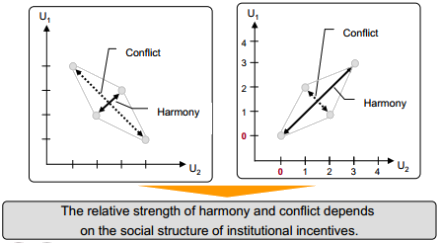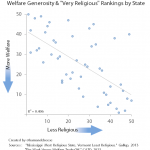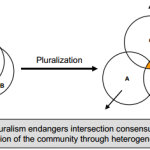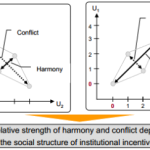Lamenting the atomism of modern society, the decline of community, associations and other forms of “social capital,” is such a common refrain on both the left and right that one wonders why they haven’t put aside their differences to form a club! I hear there are some vacancies down at the YMCA, and I bet you rates have never been so good. Call it… the Enemies of Anomie & Toastmasters Society.
Yet theorists of social capital spend more time writing about it (in itself a highly autonomous practice) than they do actually forming new co-valent social bonds. Perhaps its because, for both camps, the decline is seen to have been caused by such deep and hard to resist forces that they are equally resigned to pontification.
On the right, the deep source of creeping atomism is the all-encompassing, bureaucratized welfare state. Redistribution in this view is inherently trust-reducing due to its zero-sumness (Mary robbing Peter to pay Paul). For example, its argued that universal social programs crowd-out private safety-nets, like religious organizations or the family, destroying unseen pro-social externalities. In some accounts this merely accelerates a feedback loop of eroding social norms that was initiated the second Western Civilization embraced value pluralism.
Surprisingly, many on the left have come to similar conclusions, if only in a different vocabulary. Habermas, for example, has argued that state welfare systems “colonize” more natural forms of solidarity, contributing to their “reification” — an objectifying process by which implicit social relations are made explicit and impersonal, sapping them of their moral character. Readers of Sweet Talk might know this as a re-balancing from the sacred to the profane, the inherent transcendental and instrumental duality of all social relations.
Get Evonomics in your inbox
Heady stuff. But is any of it accurate? Is it an inexorable law of late capitalism that we become individuated narcissists? Is there some theorem in Public Choice that says more welfare = less social capital? The answer to both is a big fat no.
In fact, the inverse relationship between social capital and the modern welfare state has been greatly exaggerated. There are three main reasons for this tendency, which I explore below:
Too much of the analysis has focused on the US
Robert Putnam’s Bowling Alone is surely the most extensive and influential survey into the decline of social capital, and is an important work. But its subject is exclusively the United States, which makes it extremely difficult to draw any causal inference into the “collapse of American community”. This isn’t for lack of other research. There are now many studies into the determinants of social capital in Europe. Not only has there been no comparable collapse in social capital, on the role of welfare results by–and–large contradict the US narrative. Indeed, empirical studies tend to talk of welfare being “trust enabling”.
Independent of these empirical problem, it is difficult to draw general conclusions about the effects of welfare policies by studying the US for the simple reason that its social programs are delivered in such bad faith and with manifestly poor design. It’s gotten so bad political scientist Steven M. Teles had to coin a new term for it, Kludgeocracy: a system of government befitting “an ill-assorted collection of parts assembled to fulfill a particular purpose”. In his own words:
For any particular problem we have arrived at the most gerry-rigged, opaque and complicated response. From the mind-numbing complexity of the health care system, our Byzantine system of funding higher education, and our bewildering federal-state system of governing everything from the welfare state to environmental regulation, America has chosen more indirect and incoherent policy mechanisms than any comparable country.
An optimist might argue that the US just takes the theory of the second best really, really seriously. Unfortunately, the more plausible story is that America’s political system produces abnormally bad policy. Putnam famously argued that social capital, manifested in high levels of trust and civic engagement were essential to an effective democracy. Though I agree, I suspect in America’s case the causality runs mostly the other way. Extreme democratic dysfunction is fuel to civic apathy and distrust of conventional sources of authority. Indeed, being suspicious of government is a time-honored American tradition. The fact that so many conspiracy theorists focus on the US government thus isn’t surprising. The level of surface incompetence is so utterly beyond belief that Infowarriors sound reasonable to insist it must be a cover for some hyper-competent core.
But just as there’s no good reason to expect the effects of US social policy to match more coherent welfare regimes, there is no necessary reason US policy has to be so incompetent and self-sabotaging going forward. There are legislative ideas out there that could dramatically simplify the US welfare system overnight. Yet, for reasons likely inherent to the structure of US federalism, America has so far earned its title as the reluctant welfare state.
Aggregation misses the important details of institutional design
I got acquainted to the kludge through my own research into the effects of welfare expansion on religious affiliation. I even had empirical results that track closely with the view the social programs crowd-out private forms of collective action. As I wrote in my honours thesis conclusion,
Religious organizations, as natural providers of community social insurance, are entwined in the U.S. hospital care system. But with the rapid expansion of state subsidized health spending on the poor … Medicaid and Medicare expansions interacted with the increasingly profit-oriented hospital sector, and many religious hospitals closed down or converted to secular ownership. Falling congregational membership followed suit … This is one example of the non-neutrality of the U.S. welfare system on forms of social capital.

But to view this as a choice between public health care and community provision is a false dilemma. In order to de-stylize ones facts one must look to the deeper parameters. In this case, social capital was damaged precisely due to the perverse ways public and private spheres interacted in the US health system. As nursing professor Dr. Barbra Mann-Wall has written, due to the nascent pool of federal Medicaid and Medicare dollars that became up for grabs, the 1980s
witnessed the growth of for-profit hospital networks, resulting in increased vulnerability of smaller not-for-profit institutions. More than 600 community hospitals closed. It was at this time that both for-profit and not-for-profit institutions began forming larger hospital systems, which were significant changes in the voluntary hospital arena. …The balance of power in these institutions shifted from caregivers to the organized purchasers of care, with Medicare and Medicaid becoming a huge governmental influence in all types of hospitals.
If there’s any common denominator to the worst US federal programs, it’s surely the degree of centralization. For comparison, consider that Sweden is one of most comprehensive welfare states in the world but also ranks near the top in measures of social capital. Part of the reason may relate to the high level of decentralization of many key social programs. For example, financing and delivering healthcare is the responsibility of County Councils, while welfare, disability and elderly are controlled by municipalities. Swedes also have very high rates of union membership. Yet instead of being confrontational with the employer, the norm is mutual advantage. In turn these unions are entrusted to manage stuff that in the US would be cynically regulated, like employee insurance and sick leave.
Economists extol the virtue of this kind of decentralization or subsidiarity for reasons of asymmetric information. That’s a reified way of describing the truism that in tight communities, everyone knows everybody. I was astonished to learn, for instance, that 75% of Swedes report attending “study circles,” 10% on a regular basis. These are regular meetings of a dozen or so people organized by larger voluntary associations that “range from the study of foreign languages to cooking to the European Union question.”
The typical response is to ascribe it all to Nordic cultural homogeneity. The problem is that when this isn’t just code for race, it is in many ways no more than a synonym for strong social capital, and therefore explains the phenomena self-referentially. Nonetheless, it doesn’t alter the fact that changes in welfare policy within Nordic countries shows no evidence that thick communities and welfare are substitutes, either.
The redistributionist model of the welfare state is taken for granted
The embrace of egalitarianism by the American left ensures discourse on welfare is biased to a trust reducing conclusion. Indeed, the welfare state a la John Rawls and the rent seeking state a la Gordon Tolluck basically agree that the state primarily exists to redistribute. If you’re on the right, it’s taking from the makers and giving to the takers, while the left romanticizes itself as a Robin Hood-esque rebuke of trickle down economics. Either way, all metaphors of class conflicts and opposed interests are framed as a fight over a fixed pie.
This is unfortunate, since the egalitarian logic rarely fits the facts. As philosopher Joseph Heath has pointed out, the largest “welfare programs” in advanced economies are really better characterized as state level insurance schemes that have historically arisen due to high transaction costs and economies of scale. “The tendency to misclassify social insurance programs as redistributive is quite firmly entrenched in the literature,” he writes:
There is, of course, a sense in which any system of insurance is redistributive, in that its net effect will be to transfer money from the lucky to the unlucky. But this is true regardless of whether it is public or private. Car insurance transfers money from those who don’t have accidents to those who do, just as health insurance transfers money from those who don’t get sick to those who do. In both cases, however, the logic of the redistribution is not egalitarian, but rather assurentiel. This is reflected in the fact that, first, people voluntarily buy insurance, because the transaction is Pareto-improving ex ante, and second, there is nothing to stop the transfers from being regressive with respect to income.
The pension system, a supposed “paradigm case” of wealth transfer, isn’t even obviously progressive in its effects:
Indeed, one of the factors that diminishes the level of progressivity of the system as a whole is that the rich tend to outlive the poor, and the core function of the system is to redistribute from those who die young to those who live for a long time. This is because the retirement system in the Social Security program is essentially a defined benefit pension scheme, which is to say, a collectively purchased life annuity. And a life annuity is an insurance product, designed to protect individuals from the risk of outliving their savings.
Recognizing the efficient logic of welfare states is essential to defeating the fallacy that they erode trust and create dependency. In economics, the key virtue of efficiency is that it represents a win-win space, characterized socially by a sense of harmony through mutual advantage. This is the central conclusion of Ordonomics, an approach derived from ordoliberalism that bridges economic and institutional systems with semantic or ethical discourses. In a presentation on Ordonomics, German economist Ingo Pies illustrates the conventional view of how cultural pluralism reduces the intersection of common values:

A model of community erosion
But rather than erode community, value heterogeneity leads to the consensus around liberal norms like tolerance. This follows the same Pareto logic of social welfare, which Dr Pies calls the “orthogonal position”. In contrast, solely relying on egalitarian logic insists on making a “rotten compromise” which risks conflict where two value systems are in tension. In the United States this manifests in the perennial debate over whether welfare recipients deserve to be stigmatized. Importantly, the social structure of institutional incentives is paramount to whether harmonious interaction reigns supreme:

Egalitarian logic embraces conflict over harmony
Even a country with heterogeneous values has ample space for harmonious and welfare enhancing cooperation. This includes the provision of social services, which is a homogeneous enough product to unite the most heterogeneous value pluralists together in cooperation. As political scientist Bo Rothstein wrote of the Swedish welfare state, “its main architects sought a social policy based on the idea of ‘people’s insurance’ that would supply all citizens with basic resources without incurring the stigmatization associated with poor relief.” In turn, the people’s insurance enhanced social capital across Scandinavia by giving responsibilities of provision to civil society and voluntary associations.
It is of course true that before social insurance swept the modern world private forms of charity and mutual aid filled the gap. But we must never forget that social capital in this era was built on sacrifice and stigma, which put massive epistemic burdens on collective action, and oriented opposing communities in conflict. In contrast, modern forms of social capital are secured without sacrificing freedom of conscience or value plurality. It is in this spirit that Kant defined human dignity as the moral self-constitution of autonomous subjects. Sadly, that the US is such an exception to the rule betrays the cynicism of its political order, and leaves the average citizen poorer and less dignified for it.
Originally published here.
2016 February 4
Donating = Changing Economics. And Changing the World.
Evonomics is free, it’s a labor of love, and it's an expense. We spend hundreds of hours and lots of dollars each month creating, curating, and promoting content that drives the next evolution of economics. If you're like us — if you think there’s a key leverage point here for making the world a better place — please consider donating. We’ll use your donation to deliver even more game-changing content, and to spread the word about that content to influential thinkers far and wide.
MONTHLY DONATION
$3 / month
$7 / month
$10 / month
$25 / month
You can also become a one-time patron with a single donation in any amount.
If you liked this article, you'll also like these other Evonomics articles...
BE INVOLVED
We welcome you to take part in the next evolution of economics. Sign up now to be kept in the loop!


























